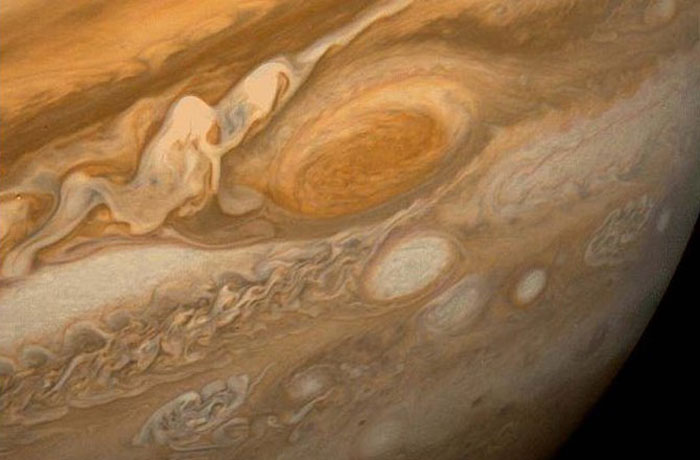.

An iconic view of Jupiter's Great Red Spot as seen by the Voyager 1 spacecraft in 1979.
.
As the tally for planets beyond the solar system began climbing, a team of scientists noticed something strange. Most of the other systems in the galaxy had planets bigger than Earth orbiting closer to their parent stars than Mercury circles the sun.
“In our solar system planets are pretty widely spread out and there’s literally nothing inside of Mercury’s orbit,” astronomer Gregory Laughlin, with the University of California Santa Cruz, told Discovery News.
“The fact that the default mode of planet formation ... is leading to configurations that are totally unlike our own solar system is something I found really curious. The main feature of our solar system is that the inner part is just missing,” he said.
Enter the “Grand Tack” theory of our solar system’s formation, which suggests that in its infancy, giant Jupiter spiraled inward, swept by the gravitational wake of its own buildup. Like a cosmic bull in a celestial china shop, Jupiter’s gravity would have flung asteroids and proto-planets every which way, creating a shooting arcade that could have easily destroyed planets in the region, Laughlin said.
The story would have ended there were it not for Saturn, which evolved somewhat later and ended up with enough gravitational muscle to counteract Jupiter’s inward spiral, freeing the giant planet to shift back beyond Mars, or so the Grand Tack theory holds.
That left the inner solar system clear for a second-generation of planets to form, Earth among them.
Laughlin and colleagues were less interested in proving Jupiter’s navigational prowess than looking at what impacts the migration could have had.
“Anytime a theory says 'Well this happened and then this happened,' you need to be naturally suspicious. I think that is completely, absolutely valid and the right standpoint to take,” Laughlin said.
But looking at the consequences of the migration provides a very nice test, he added.
The computer models show a very natural mechanism for destroying any super-Earths that may have resided in the early solar system. Conditions were right for not only lots of collisions, but high-speed ones as well, a study published this week in the Proceedings of the National Academy of Sciences shows
“They’re pretty violent collision because the planetesimals are on very different paths. They collide with velocities of about 5 kilometers per second -- a couple of miles per second -- which when you have 100-kilometer objects they're just incredibly energetic and damaging events,” Laughlin said.
Collisions cause more fragments, leading to yet more collisions, the study shows.
“If our solar system had started out as a normal, standard-issue solar system, it shows that the Grand Tack could have very handily kind of wiped the slate clean and destroyed any planets that originally were interior to Mercury’s orbit,” Laughlin said.
Earlier this year, another team of researchers found evidence for early planetary migration in the hodgepodge of asteroids and other objects that ended up orbiting between Mars and Jupiter.
“I see the asteroid belt as a gold mine for refining or refuting planetary migration models,” astronomer Francesca DeMeo, with the Harvard-Smithsonian Center for Astrophysics, told Discovery News.
“What's really promising is to see multiple puzzles of solar system history solved in a single model, but the theory is still relatively young so we should remain open-minded,” she added.
“This work takes us a step closer in understanding what it takes to build a ‘Goldilocks planet’ that could support life and how unique the conditions had to be to create Earth,” DeMeo said.
Quelle: D-News
4626 Views
